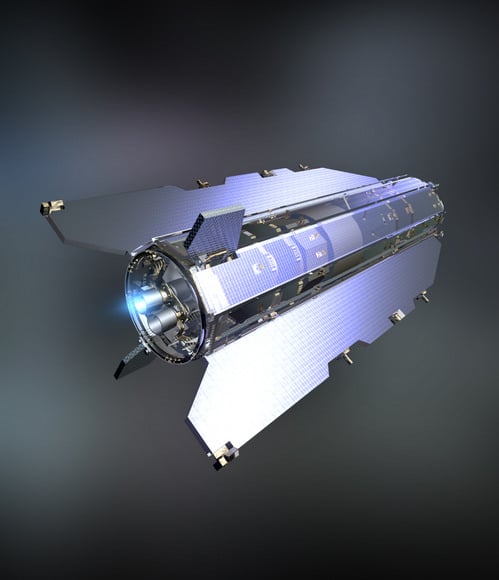[/caption] This has to be the sexiest looking spacecraft ever built by humankind. No, it's not a starship or battle cruiser (although it does look a little like the
Eagle spacecraft from the old television show Space: 1999)
. This sleek, slender, sexy, shiny and sophisticated spacecraft is an Earth-orbiting satellite that will investigate our planet's gravitational field and map the reference shape of our planet â€" the geoid - with unprecedented resolution and accuracy. GOCE, or the Gravity field and steady-state Ocean Circulation Explorer is scheduled to launch on Wed. September 10 at 16:21 CEST (14:21 UTC). Why such a sleek design? As GOCE Systems Manager Michael Fehringer says, "Form follows function not only in the world of fashion! To fly low and avoid air drag, the best shape for the satellite to be is long, slender and absolutely symmetrical along the direction of flight."
ESA’s 1 ton, 5 meter-long spacecraft will be in an extra low orbit (260 km, or 161 miles) and will experience drag from Earth's upper atmosphere, so smooth and lean helps reduce the friction. Adding to the sleek design is that the solar panels are attached to the long body of the satellite instead of sticking out clumsily and adding to the drag. ESA has a
great animation
of GOCE in flight. Although the design will help, the spacecraft will need a boost to its orbit occasionally, and has state of the art ion engines.
[caption id="attachment_17746" align="alignnone" width="166" caption="GOCE on the launchpad. Credit: ESA"]
[/caption] GOCE will be in a sun-synchronous orbit, meaning it will be almost always be in sunlight, providing a stable thermal environment for the spacecraft.
The instruments are all placed along the axis of the satellite's body, adding to its sleekness -- check out this
great animation.
GOCE carries a set of six state-of-the-art high-sensitivity accelerometers to measure the components of the gravity field along all three axes. The data collected will provide a high-resolution map of the geoid and of gravitational anomalies. This will greatly improve our knowledge and understanding of the Earth’s internal structure, and will be used as a much-improved reference for ocean and climate studies, including sea-level changes, oceanic circulation and ice caps dynamics survey. Numerous applications are expected in climatology, oceanography and geophysics, as well as for geodetic and positioning activities.
Here's an
interactive feature
to take a closer look at the spacecraft.
Oooo. It's enough to make a girl purr.
Source:
ESA
Also, check out
Ian's article on Astroengine
 Universe Today
Universe Today
